China, a major global manufacturing center, has drawn the attention of countless foreign buyers interested in custom-made sofa cushions. Filling materials are crucial to customization, as filling quality and performance directly impact the sofa’s comfort and durability.
In this blog post, we will explore the top 6 options for sofa cushion filling materials:
- Foam sofa filling
- Memory foam stuffing
- Synthetic fiber and cotton filling
- Feather and down stuffed sofa
- Latex-filled sofa cushions
- Foam vs latex vs down, which is the best?
- Springs and pocket springs
Have a quick view of each filling material’s characteristics, suitable applications, as well as their impact on sofa cushion comfort and quality. Then, you can find the ideal filling material, based on your target consumer group’s preferences and project budget.
Foam sofa filling
Foam is the most common filling material, derived from petroleum, and known for its elasticity. Sofa cushions filled with foam are lightweight, soft to the touch, and most importantly, cheap.
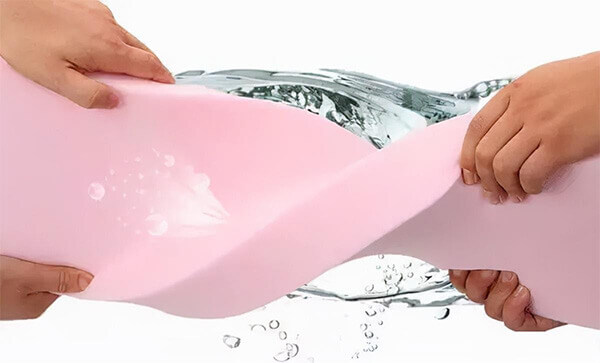
However, the quality of foam can vary. High-quality foam is odorless, environmentally friendly, and free from pollution, with quick rebound time when seated or getting up. Generally, the higher the foam density, the better the quality. When used as a filling material in sofa cushions, higher-density foam provides better elasticity, support, and increased comfort. You can distinguish foam quality by comparing the foam density — its weight per unit volume.
There are 3 main types of foam densities on the market:
Low-density foam
The density < 18kg/m³.
Medium-density foam
The density is in the range of 20kg/m³ – 45kg/m³. For fabric sofas, cushions are best filled with foam above 30kg/m³, typically using whole blocks of foam. An optimal approach is combining high-resilience foam (above 30kg/m³) and down or synthetic cotton, enhancing comfort and durability.
High-density foam
The density ≥ 45kg/m³. It boasts excellent elasticity, high compression load, good flame resistance, and breathability. Often used for sofa back cushions. 50kg/m³ foam is suitable for making firm sofa cushions.
In practice, manufacturers improve the comfort for sitting or lying down by giving foam a soft treatment, increasing resilience and anti-aging properties without reducing density.
How to differentiate between good and bad foam?
1. Observe and check the foam’s pores.
High-quality foam usually has smaller and more uniform pores, with a smooth surface. But this is not applicable to convoluted foam and memory foam.
2. Smell the foam.
Good foam has little to no odor, while poor-quality foam has a strong and unpleasant smell. Poor-quality foam can be made from recycled materials with more impurities, harming health.
3. Press the foam with your hand and watch how quickly it bounces back.
Quality foam will rebound faster, whereas lower-quality foam will take longer to regain shape.
4. Sit on the foam and personally feel the comfort.
The more comfortable the sofa cushion, the better the foam quality. This is the simplest and most straightforward way to assess the foam’s quality.
Foam-stuffed sofas often lack breathability and have a high water absorption capacity, causing the body’s heat to dissipate slowly. Prolonged use of non-breathable sofa cushions can lead to the growth of bacteria, potentially affecting human health. Over time, the cushions may deform or sag, requiring regular flipping and patting to maintain their shape.
Memory foam sofa filling
Memory foam is a type of open-cell, temperature-sensitive memory particle that conforms to the body’s contours, providing a completely pressure-free and supportive sitting experience. High-end sofas often use memory foam, in addition to traditional high-density foam, to offer a more comfortable sitting sensation.
The sofa stuffed with memory foam reacts to body heat and adjusts to the individual’s comfort, providing personalized support. Even when the sofa is compressed and sinks under pressure, memory foam filling ensures there is minimal to no strong rebound force. Apart from the higher price, memory foam filling has no other issues and offers a great seating solution.
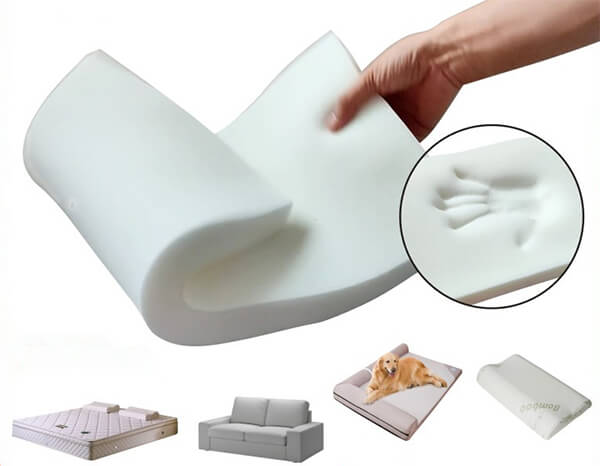
Synthetic fiber and cotton filling
This refers to polyester fiber or fluffy cotton as upholstery stuffing for sofa cushions. It provides excellent softness and a comfortable sitting experience. But the cons are lower mechanical strength and a smaller compression load, easy to deform over time. Oftentimes, it is more suitable for back cushions.
This type of upholstery stuffing material’s advantages include moderate price, easy cleaning and maintenance, and allergy resistance.
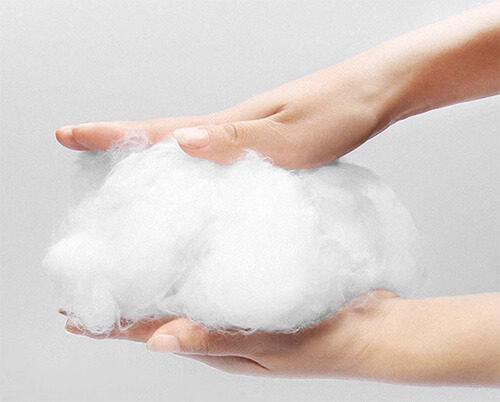
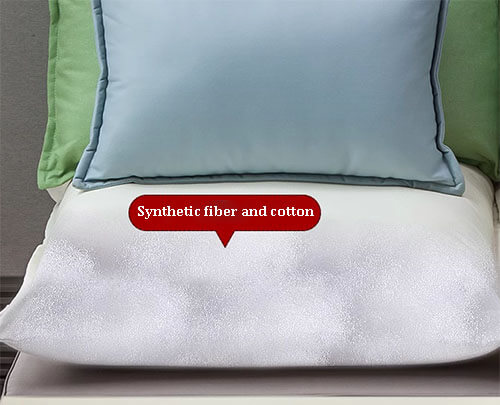
Feather and down filling
Feather refers to the plumage of birds, while down is the soft, fluffy plumage that grows on the underside of geese and ducks, resembling the shape of reed catkins.

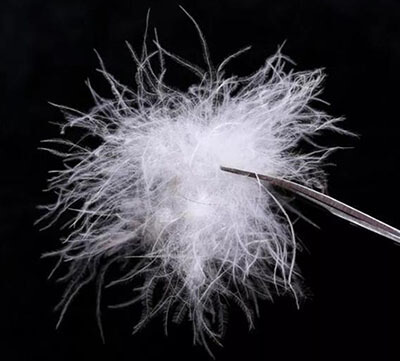
Down provides a soft and comfortable feel, with high loftiness and excellent insulation properties, making them breathable and thermally insulating. Down is commonly used in high-quality winter clothing and bedding items due to its superior warmth. On the market, the price ranking is as follows:
White Goose Down > Gray Goose Down > White Duck Down > Gray Duck Down.
Compared to cotton sofas, down-filled sofas offer a more comfortable sitting experience and are less prone to deformation. They have a longer lifespan, typically lasting twice as long as foam sofas, often exceeding ten years.
Down-filled sofas are commonly featured in high-end sofas or used in combination with foam. Suitable for purchasers with a higher budget. However, it’s essential to be cautious, as some manufacturers may use inferior materials or defective down to produce fillings.
Indeed, down has numerous advantages, but its drawbacks are also evident.
If a sofa is filled with pure down, it might become too soft, resulting in slow rebounding. Additionally, some individuals may have allergies or sensitivities to feathers.
Besides, the processing of down is intricate and involves many steps from initial feather inspection, water washing, centrifugal water removal, disinfection through drying, to cooling, dust removal, feather separation, and blending. If manufacturers do not meet the standards for down processing, there will be hygiene issues and poultry odor. Generally, goose down has a milder odor compared to duck down.
Over time, down-filled sofas may experience down migration, which can affect both comfort and aesthetics. To prevent down migration, manufacturers often mix down with other filling materials or use fabric compartments to secure the down in place.
Additionally, down-filled sofas can be challenging to clean. Improper washing or exposure to moisture can result in unpleasant odors. Regularly patting and fluffing the sofa is necessary to restore its shape and extend the lifespan of the down-filled sofa.
Latex filling
In recent years, there has been a rise in natural latex filling, derived from the sap of rubber trees. Initially used only for pillow filling, it has gradually found its way into sofas, offering excellent value for money and far surpassing the comfort of foam sofa cushions.
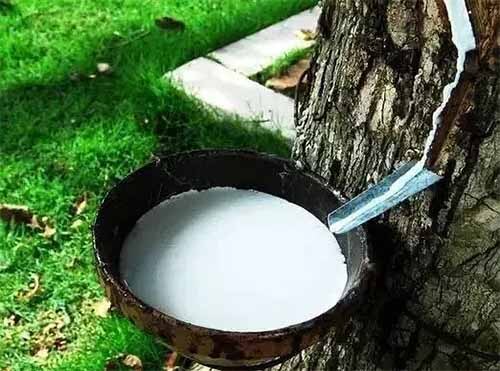
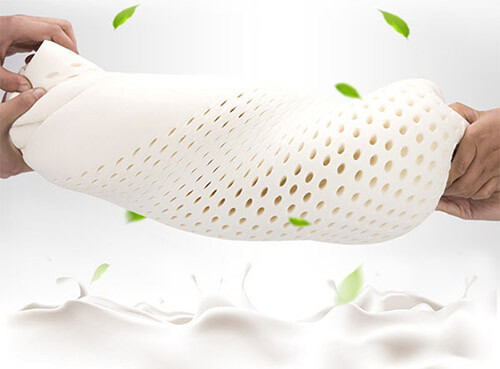
Latex provides complete insulation and is anti-static. Its texture is soft and highly elastic, with ten times the rebound force of foam. Latex sofas maintain their shape, never sagging or losing their support over time. They contour perfectly to the body, allowing people to release their stress and sit comfortably for extended periods without feeling fatigued.
Natural latex contains oak protein components, which have antibacterial and mite-resistant properties. This is an ideal furniture filling from a hygiene perspective. Additionally, latex’s excellent breathability allows it to provide warmth in winter and keep cool in summer.
Indeed, natural latex products are expensive due to limited production and high demand. Driven by high profits, some businesses may resort to using synthetic or mixed latex to mimic natural latex. Additionally, be cautious about the supplier’s claims of 100% pure natural latex. Because authentic latex can not be molded in that form. For sofa filling, a latex content of 80% is considered high-quality latex sofas.
Springs and pocket springs
To boost the comfort of sofas, springs are often added to the interior. There are 2 common types of springs used in sofas:
Coil springs
In simple terms, coil springs are tightly interconnected, providing excellent support, high firmness, and durability. However, when one area is compressed, nearby coil springs are also affected, leading to friction and some noise.
A common example is when sitting on a sofa, sudden pressure from another person can cause a “squeaking” sound as the coil springs react. The person already on the sofa may experience a slight bounce due to this interaction. This is where individually pocketed coil springs excel, as they perfectly avoid such experiences by isolating each spring independently.
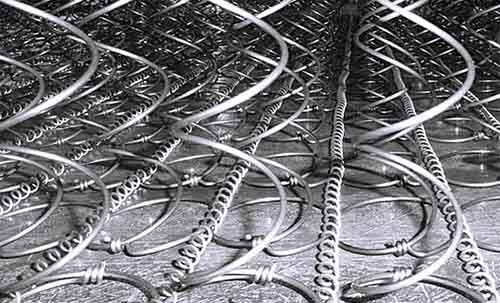
Pocketed coil springs
Pocketed coil springs refer to individual springs each encased in a fabric pocket, allowing them to operate independently. The vibrations of one spring won’t affect the surrounding ones, resulting in minimal friction and noise. Ideal for making mattresses and sofas.
Sofas made with pocketed coil springs can accommodate the movements of nearby individuals without disturbing others on the sofa. Moreover, these individually pocketed springs evenly distribute pressure across the body, providing excellent support and comfort.
Regarding the price, pocketed coil springs are more expensive than coil springs. But if a specific area of the sofa with pocketed coil springs is frequently compressed, it can significantly reduce the localized elasticity. Additionally, when making a purchase, it’s essential to inquire about the number of coils and the thickness of the steel wire. Typically, a suitable option would be around 5 to 7 coils with a wire thickness of 1.8 to 2.4mm, ensuring long-lasting durability.
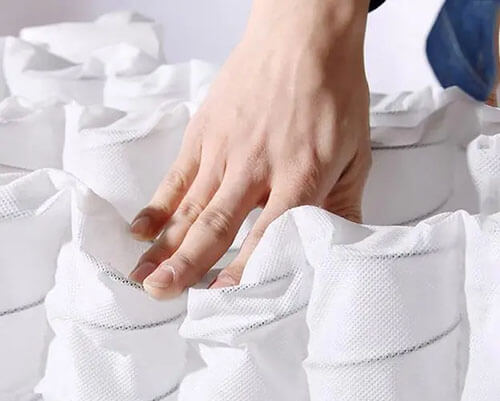
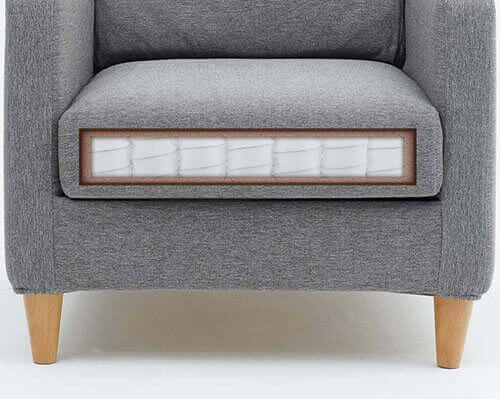
Foam vs latex vs down, which is the best stuffing for couch cushions?
Each has its own advantages. The choice depends on your specific needs.
In the sofa market, pure foam is the most common filling material, followed by a combination of foam and other fillings. Foam, latex, down, and springs are also often used together, forming a sandwich-like structure:
One layer of latex (or foam, down) + one layer of springs + one layer of latex or foam, down, etc.
The combination of various fillings and springs allows for better strengths and avoids weaknesses, providing excellent comfort.
As a leading sourcing company in China, JingSourcing has integrated quality suppliers specializing in manufacturing sofa cushions into our database.
For your custom sofa project, we can quickly find suitable suppliers for you and provide competitive quotes. We support sofa cushions made of various filling materials of good quality and meet safety requirements. Our professional agents will assist you in selecting the best printing methods to achieve your desired custom cushion cover in the most cost-effective way. And we follow up on production, inspect finished products and arrange shipments to your place at the best rates.



Leave A Comment